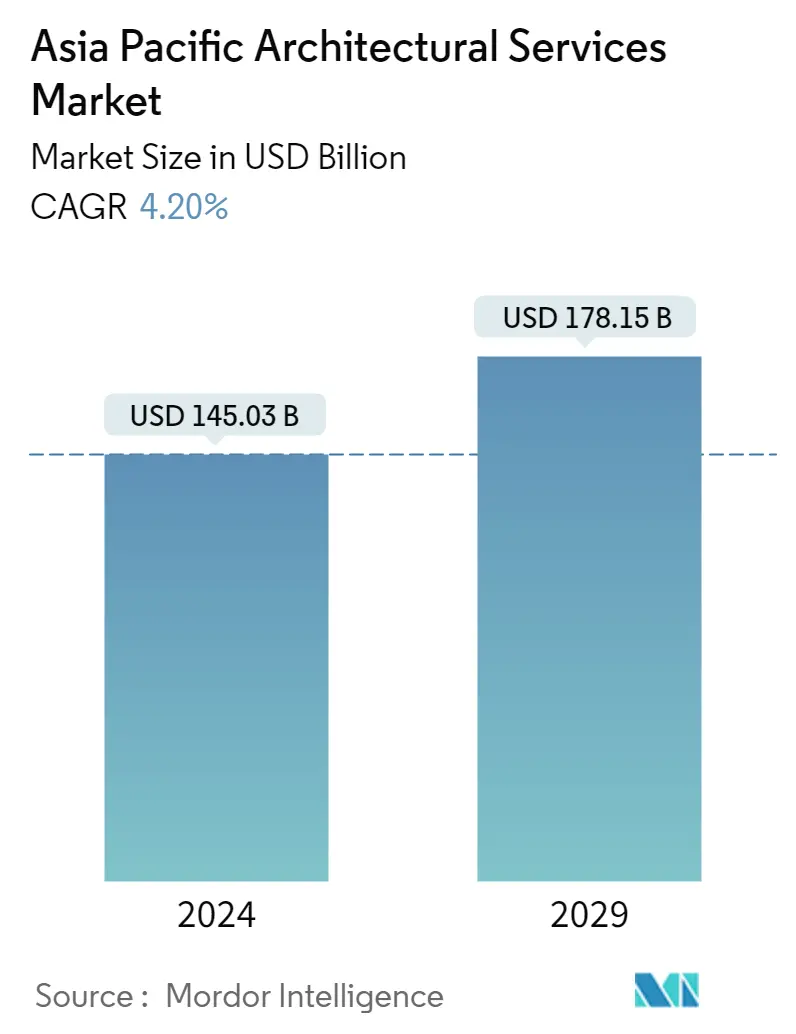Market Size of Asia Pacific Architectural Services Industry

| Study Period | 2019 - 2029 |
| Base Year For Estimation | 2023 |
| Market Size (2024) | USD 145.03 Billion |
| Market Size (2029) | USD 178.15 Billion |
| CAGR (2024 - 2029) | 4.20 % |
| Market Concentration | Medium |
Major Players
*Disclaimer: Major Players sorted in no particular order |
Need a report that reflects how COVID-19 has impacted this market and its growth?
Asia Pacific Architectural Services Market Analysis
The Asia Pacific Architectural Services Market size is estimated at USD 145.03 billion in 2024, and is expected to reach USD 178.15 billion by 2029, growing at a CAGR of 4.20% during the forecast period (2024-2029).
Rapid urbanization, increasing demand for smart homes, and rising commercial and industrial building infrastructural upgradation activities across the globe are among the significant factors driving market growth.
- Architectural planning witnessed a paradigm shift in the last few years due to computer software's emergence. Advancements in digital design tools, computer-controlled fabrication, computer-controlled connectedness, and interconnectedness have enabled a new phase of the designing and building processes.
- Architectural services comprise a wide variety of processes, including feasibility studies, architectural programming, project management with the help of design, preparation of construction documents, and construction administration. The increasing demand for green buildings drives the architectural services market, as sustainable construction provides essential benefits and business opportunities. Moreover, the return on investment can be improved, along with the occupancy, thereby saving operating costs.
- The Asia Pacific region is characterized by significant ongoing and upcoming infrastructural projects, particularly smart city projects, across Singapore, China, Japan, and India, which may create a demand for architectural services. According to the India Brand Equity Foundation (IBEF), the real estate sector in India is expected to reach a value of USD 1 trillion by 2030, which may account for over 13% of the country's GDP by 2025.
- In the context of technology insertion, homes are adopting automation and transforming it into smart homes. New buildings are designed by keeping automation as the top priority. Automated systems aid in functions like security, temperature control, and lighting, which help control bills and positively impact the environment and the surroundings.
- Furthermore, the architectural industry in the Asia Pacific region is growing considerably, with an increasing number of new architectural firms entering the market with innovative designs and software, thereby providing better services, such as enhancements in urban planning. These advancements are expected to increase the demand for upgraded design technology involving 3D models and high-end designing software. The entry of new players is backed by several investments from venture capital firms, which supports the growth of the studied market.
- However, low awareness compared to the developed regions, along with higher costs involved and a shortage of qualified individuals with design and execution expertise, are among the most significant impediments to the growth of the studied market in the Asia Pacific region.
- The COVID-19 pandemic negatively impacted firms offering architectural services, especially during the initial phase. The widespread lockdown imposed across various countries significantly reduced construction activities, bringing a slowdown in demand for architectural services. However, the market regained momentum as the condition improved and moved towards normalcy due to the widespread vaccination in the region. It is expected to follow a similar pattern during the forecast period.
